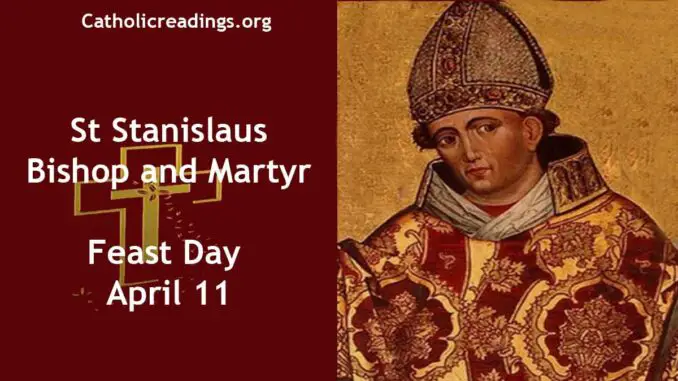St Stanislaus, or Stanisław was Bishop of Kraków, Poland. He was born on July 26 1030 in Szczepanów, Poland, and died on April 11 1079 at the age of 48 in Kraków, Poland.
We celebrate his feast day on April 11 every year in the Catholic Church.
Saint Stanislaus of Szczepanów is the Patron Saint of
- Poland
- Kraków
- Moral order
| St Stanislaus, Bishop and Martyr Biography | |
|---|---|
 St Stanislaus, Bishop and Martyr – Feast Day – April 11 2026 | |
| Date of Birth | July 26 1030 |
| Place of Birth | Szczepanów, Poland |
| Profession | Bishop of Kraków |
| Place of Work | Kraków, Poland |
| Date of Death | April 11 1079 (aged 48) |
| Place of Death | Kraków, Poland |
| Feast Day | April 11 |
| Beatification | By Pope Leo XIII on February 19 1888 in Saint Peter’s Basilica |
| Canonization | By Pope Innocent IV on September 17 1253 in Assisi, Italy |
| Patron Saint of |
|
St Stanislaus of Szczepanów Life History
Stanislaus or Stanisław was born in Szczepanów, Poland, as per the traditional account. He was the only son of his parents, Wielisław and Bogna, who were both noble and devout.
Stanislaus received his education at a cathedral school in Gniezno, which was the capital of Poland at the time and also studied in Paris.
When he returned to Poland, Lambert II Suła, the Bishop of Kraków, ordained him as a priest. Following his ordination, he was appointed as a canon at Kraków and gained recognition for his preaching.
Later, he was appointed as a pastor in Czembocz, close to Kraków, and also served as a canon and preacher at the cathedral. He was subsequently promoted to the position of vicar-general.
Following the death of Bishop Lambert II Suła in 1072, St Stanislaus was appointed as the new bishop of Kraków.
However, he agreed to assume the role only when instructed to do so by Pope Alexander II. Stanislaus was among the first Polish bishops who were native to the country.
Additionally, he served as an advisor to the Duke and had some sway over Polish politics.
Stanislaus achieved several significant feats during his lifetime. For instance, he succeeded in inviting papal legates to Poland and also played a key role in the restoration of a metropolitan see in Gniezno.
This move was crucial for the coronation of Duke Bolesław as king in 1076. Subsequently, Stanislaus urged King Bolesław to establish Benedictine monasteries as a means of facilitating the Christianization of Poland.
Stanislaus initially clashed with King Bolesław over a land dispute, but their conflict escalated when a war in Ruthenia escalated which coupled with the information that the overseers back home were taking over the soldiers’ estates and wives, led to soldiers deserting and returning home.
In response, the King brutally punished the soldiers’ wives, leading Bishop Stanislaus to criticize him for his cruelty.
Furthermore, the bishop also criticized the King for his immoral behaviour. All these bad behaviours by the King led to the bishop’s decision to excommunicate King Bolesław, which included a ban on the canons of Krakow Cathedral from performing the Divine Office in the king’s presence.
This ex-communication was the last straw that escalated the enmity between them. It helped the king’s political opponents, and as a result, the king accused Bishop Stanislaus of treason, leading to a guilty verdict at the royal court. Bolesław labelled him a traitor to the nation.
King Bolesław ordered his soldiers to execute Bishop Stanislaus but they refused. The King himself murdered the bishop on April 11, 1079, during Mass in the Chapel outside Kraków’s walls.
The guards then dismembered the bishop’s body and scattered the remains for wild animals to consume.
This appalling act incited widespread indignation and ultimately led to the removal of King Bolesław II the Bold from power. He had to flee to Hungary, and his brother, Władysław I Herman, took over the throne.
After being forced to flee to Hungary, Boleslaus is said to have spent the remainder of his life as a penitent in the Benedictine abbey in Osiak.
The killing is reminiscent of the assassination of Thomas Becket in 1170, who was also murdered by King Henry II’s men in England.
After his death, the cult of Saint Stanislaus the Martyr began right away. People immediately started to venerate him as a martyr, and 150 years later, his remains were moved to the Wawel Cathedral complex in central Krakow.
For centuries, Polish kings were crowned at his magnificent tomb. He is considered one of Poland’s patron saints, with particular veneration in Krakow and its diocese. In 1253, Pope Innocent IV canonized Stanislaus of Krakow at Assisi.
Saint Stanislaus Feast Day
The feast day of Saint Stanislaus was initially set by Pope Clement VIII on May 7, but in Kraków, it was celebrated on May 8, which is believed to be the day of the saint’s death.
This tradition has been observed since May 8, 1254, when it was attended by many Polish bishops and princes.
However, in 1969, the Church changed the date of the feast to April 11, which is considered to be the actual date of Saint Stanislaus’ death in 1079.
Today’s Prayer
St. Stanislaus, through your fearless confrontation of those who posed a danger to the Church, you provided a courageous model of martyrdom for the whole nation.
Please assist those who implore your aid to exhibit the same level of bravery and candour as you did when confronted with challenges and hardships.
Related Links
Powered By SEO Experts
Follow @ReadingCatholic
